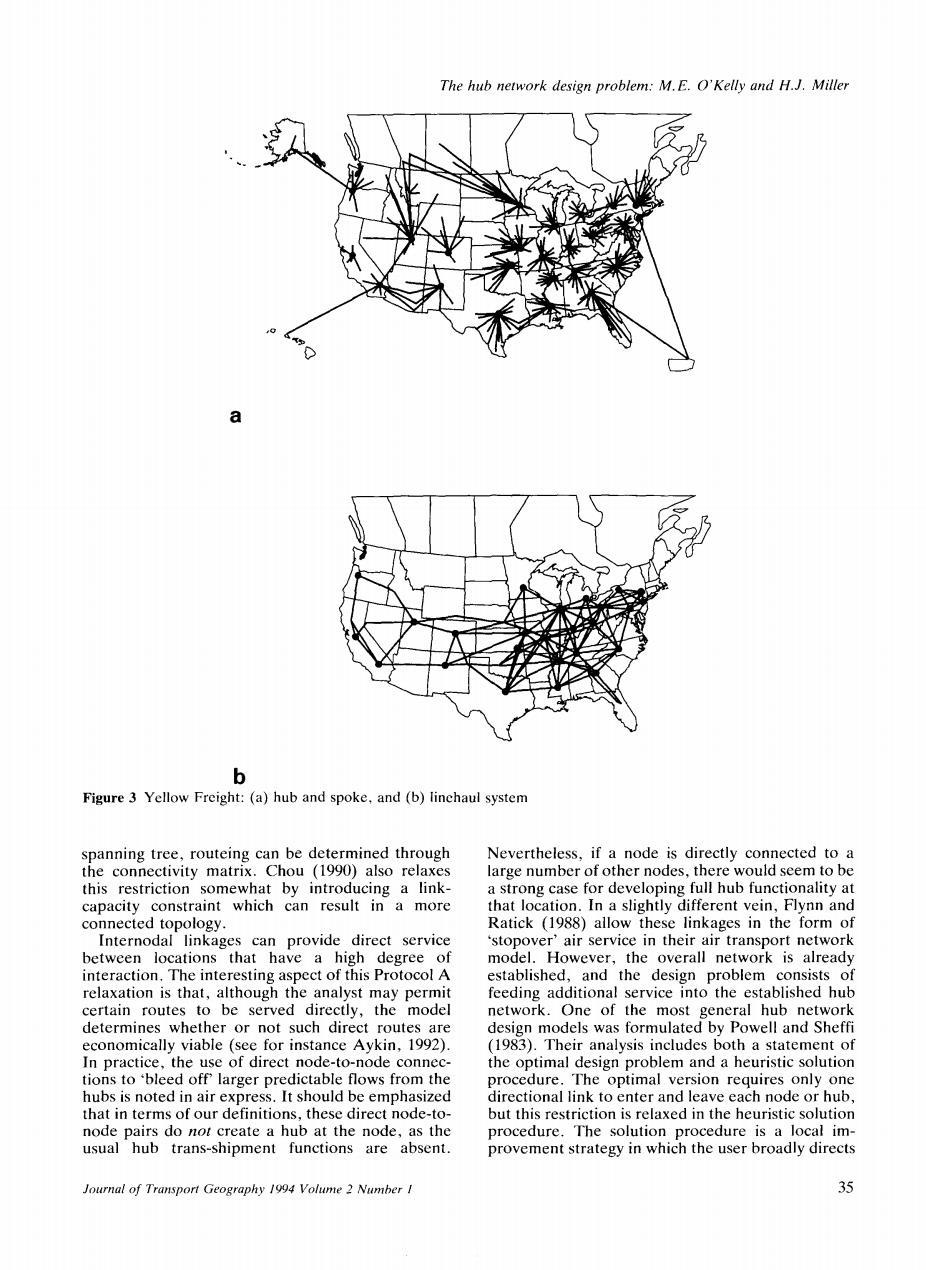正在加载图片...

The hub network design problem:M.E.O'Kelly and H.J.Miller b Figure 3 Yellow Freight:(a)hub and spoke,and (b)linchaul system spanning tree,routeing can be determined through Nevertheless,if a node is directly connected to a the connectivity matrix.Chou (1990)also relaxes large number of other nodes,there would seem to be this restriction somewhat by introducing a link- a strong case for developing full hub functionality at capacity constraint which can result in a more that location.In a slightly different vein,Flynn and connected topology. Ratick (1988)allow these linkages in the form of Internodal linkages can provide direct service stopover'air service in their air transport network between locations that have a high degree of model.However,the overall network is already interaction.The interesting aspect of this Protocol A established,and the design problem consists of relaxation is that,although the analyst may permit feeding additional service into the established hub certain routes to be served directly,the model network.One of the most general hub network determines whether or not such direct routes are design models was formulated by Powell and Sheffi economically viable (see for instance Aykin,1992). (1983).Their analysis includes both a statement of In practice,the use of direct node-to-node connec- the optimal design problem and a heuristic solution tions to 'bleed off'larger predictable flows from the procedure.The optimal version requires only one hubs is noted in air express.It should be emphasized directional link to enter and leave each node or hub that in terms of our definitions,these direct node-to- but this restriction is relaxed in the heuristic solution node pairs do not create a hub at the node,as the procedure.The solution procedure is a local im- usual hub trans-shipment functions are absent. provement strategy in which the user broadly directs Journal of Transport Geography 1994 Volume 2 NumberI 35The hub network design problem: M. E. O'Kelly and H.i. Miller a b Figure 3 Yellow Freight: (a) hub and spoke, and (b) Iinehaul system spanning tree, routeing can be determined through the connectivity matrix. Chou (1990) also relaxes this restriction somewhat by introducing a linkcapacity constraint which can result in a more connected topology. Internodal linkages can provide direct service between locations that have a high degree of interaction. The interesting aspect of this Protocol A relaxation is that, although the analyst may permit certain routes to be served directly, the model determines whether or not such direct routes are economically viable (see for instance Aykin, 1992). In practice, the use of direct node-to-node connections to 'bleed off' larger predictable flows from the hubs is noted in air express. It should be emphasized that in terms of our definitions, these direct node-tonode pairs do not create a hub at the node, as the usual hub trans-shipment functions are absent. Journal of Transport Geography /994 Volume 2 Number / Nevertheless, if a node is directly connected to a large number of other nodes, there would seem to be a strong case for developing full hub functionality at that location. In a slightly different vein, Flynn and Ratick (1988) allow these linkages in the form of 'stopover' air service in their air transport network model. However, the overall network is already established, and the design problem consists of feeding additional service into the established hub network. One of the most general hub network design models was formulated by Powell and Sheffi (1983). Their analysis includes both a statement of the optimal design problem and a heuristic solution procedure. The optimal version requires only one directional link to enter and leave each node or hub, but this restriction is relaxed in the heuristic solution procedure. The solution procedure is a local improvement strategy in which the user broadly directs 35